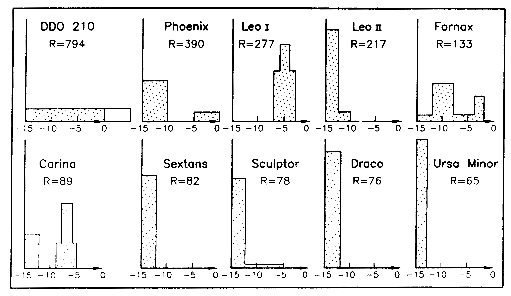


The Local Group (LG) dE's provide the most direct evidence for that something more complicated must be at work than simple expulsion of gas after the cumulative energy input to the gas from star formation exceeds the binding energy. As there have been several thorough reviews of stellar populations in Local Group galaxies in the last few years (Hodge 1989; da Costa 1991, 1994; van den Bergh 1994), we provide only a very brief summary. The existence of an ancient, globular cluster age, population in dE galaxies is inferred primarily from the presence of RR-Lyrae stars. With the possible exception of Leo I, all LG dE's have at least a small population of ~ 15 Gyr old stars. The existence of an intermediate, 2-10 Gyr age, population is inferred from the presence of carbon stars on the AGB with luminosities above that of the first giant branch tip, and, in some cases, by the presence of main-sequence turnoff stars with luminosities exceeding the turnoff for a globular cluster age population.
The mix of ages varies widely from galaxy to galaxy. Ursa Minor consists almost entirely of old stars, while Carina shows evidence of two widely separated star formation epochs, with the majority of the stars having formed in the second episode, ~ 6 Gyr ago (Mighell 1990; Smecker-Hane et al. 1994). The star-formation histories inferred from color-magnitude diagrams are summarized schematically in Fig. 6. There is some evidence that the nearer companions to the Milky Way and Andromeda galaxies have the largest proportion of old stars (van den Bergh 1994).

Figure 6. Shematic plots of star-formation rate versus time, spanning the past 15 billion years, for local dwarf galaxies. Individual panels are arranged in order of decreasing galactocentric distance R (in kpc). The figure shows that dwarfs close to the Galaxy formed most of their stars long ago, while more distant dwarfs contain young or intermediate-age stars. From van den Bergh (1994). |
The star formation histories of local dE's are clearly very complex. Evidently several of the galaxies formed some stars, then waited a few billion years to form the rest. The reasons for this are not at all understood. With a refurbished HST, we may expect much deeper color-magnitude diagrams for the Local Group dwarfs. Reaching below the main-sequence turnoff, these diagrams should yield much more detailed star-formation histories, perhaps giving us some clues to the underlying physics.